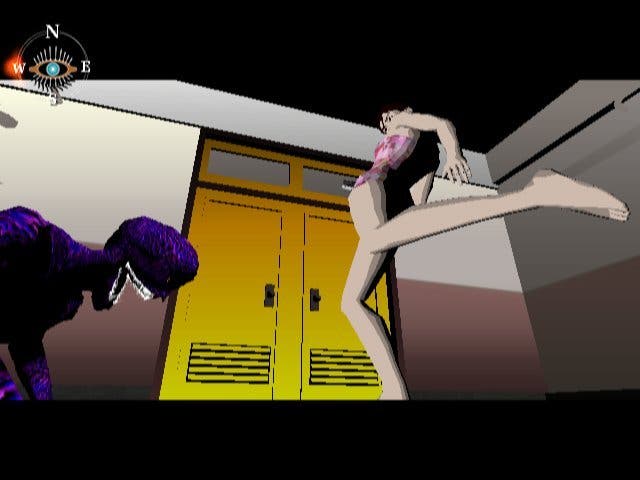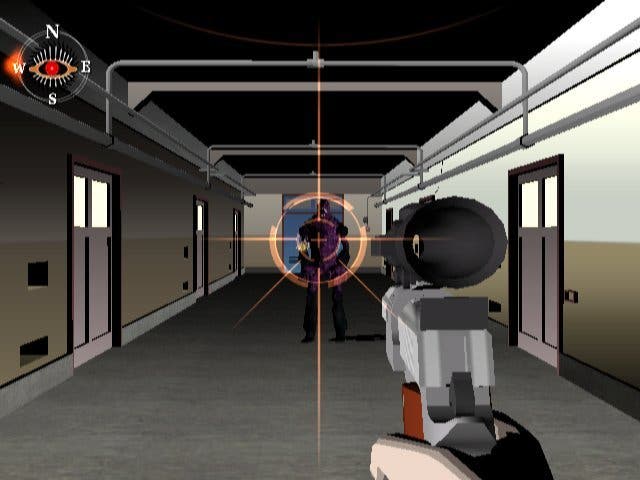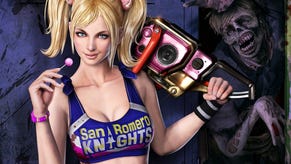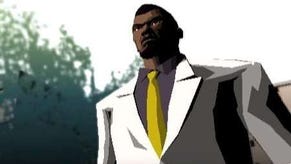Killer 7
Kristan and Tom share the same page, if not the same brain.
Kristan's take...
Few game creators could ever or would ever get away with conceiving a game that pushes its stylistic vision to the forefront of the experience, but that's exactly what Capcom and co-conspirators Grasshopper have done with Killer 7.
In many senses, Killer 7 distances itself as far as possible from the videogaming herd while also being an incredibly focused and back to basics shooter at heart; you just have to unravel a few obtuse layers to get there. While many games before it have played around with cel-shading and have made striking visual statements, few have thrown so many radical design changes at us in one go and expected the audience to take them on board.
That Killer 7 throws control and camera convention completely out of the window is one thing, but to do so without so much as even the briefest of tutorials is the biggest possible statement of its wilfully obscure arthouse intent. To thrust gamers into an environment where even the ability to move around or change the camera angle is completely at odds with anything else tells you something about where the developers' heads were at during this game's protracted development process.
For a while Killer 7 really does feel like a case of 'forget everything you know'; a bit like the sense of disorientation of getting in a left-hand-drive for the first time. And then being asked to steer with your feet, use the in-car stereo controls instead of the pedals and high-five pedestrians with your spare left hand.
As ludicrous as that analogy sounds, it's not all that far removed from Capcom's intriguing decision to map the movement controls of your character to a single button and completely remove any responsibility over the camera angle. That's right, hitting the A button has your chosen character run forward, and hitting B turns you around 180 degrees. That's it.

As you approach objects of interest (such as doors, corridor junctions, objects, NPCs) a transparent glass shard indicator slides onto the screen allowing you to interact with them. A quick nudge of the appropriate direction on the left stick confirms your choice of path, and that's all there is to the nuts and bolts of getting around Killer 7's environments.
As alien as it sounds, and as jarring as it feels when you first get your hands on it, this new control system hasn't ripped up decades of game design principles simply for the sake of being 'arthouse'. Okay, perhaps that's a matter of opinion, but by locking the camera to a midget-staring-at-your-armpit view it instantly allows Capcom to continue in its long-held desire to deliver a 'dramatic' jaunty angle on the proceedings. Remember how long Capcom persisted with the fixed cameras in Resident Evil? [*shudder* - Ed].
Whether this is a good thing or not is an argument that will rage forever, but it does - at the very least - mean that we, the viewer, get to see the game presented in The Way The Designers Intended. It's an admirably single-minded purity of vision, but a somewhat superfluous decision given that the actual meat of the game - the combat - actually takes place entirely in a manually selected first-person mode.
About eighty per cent of your time with Killer 7 will be spent trying to defend yourself from a perpetually respawning posse of exploding zombie-like creatures, known as 'Heaven Smiles' after their delightfully fixed grins. The main issue to address initially is to actually find out where the threat is coming from, due to their state of invisibility. The first thing that alerts you to their impending presence is a delirious cackle that emanates from the speakers whenever they catch sight of you. At that stage you must switch to the first-person view by holding down the right shoulder button and performing a quick 'scan' of the area with the left shoulder button. If you're looking in the right place (not always likely - they could be behind you or around the corner) they'll show up in all their vile glory, complete with a gold-yellow weak spot for you to target.

The combat system feels rather like Resident Evil 4's in many respects, and, just like Capcom's other zombie fest, the degree to how much you enjoy Killer 7 depends an awful lot on how proficient you are with the analogue stick. With practice, skill, familiarity and a succession of upgrades it's possible to really get into the Virtua Cop-style combat, but for the first few chapters it can be a real ball-breaker and somewhat unforgiving. In tandem with the overall bewilderment you'll doubtlessly experience with the unfamiliar, counter-intuitive control system, and the rambling, obtuse character interactions it's a game that takes a long time to truly appreciate.
You might rapidly come to the conclusion that Killer 7 is a complete pile of self-indulgent nonsense that's sprung forth from the minds of men bored with making conventional crowd-pleasing entertainment. It's like Radiohead's Kid A all over again. For the first few hours you'll go through the full range of emotions - from delighted admiration through to total distraught bewilderment. But whether you come full circle very much depends on what you want from videogames. Do you want to wallow in the glow of the familiar or experience something that sets out to do things differently? If it's the former then you'll almost certainly throw the pad down in disgust in less than ten minutes, but if it's the latter, then Killer 7 is likely to provide a peculiar degree of satisfaction the more time you invest in it.
There comes a turning point during Killer 7 when somehow everything starts to click into place. You stop getting so annoyed with being blown up and start appreciating that the combat's perhaps not as annoyingly simplistic as you thought it was, that the enemies don't quite wield as much power as you credited them with, and that you're not as bad an aim as you thought you were.
You also start to appreciate the puzzles for not being as elaborate and overbearing as they could have been, and start to slot into a nice rhythm that makes you want to make progress because it's actually good fun, and not merely just to 'get it out of the way' like many other games.

The other main factor we haven't discussed yet is how significant the characters are to Killer 7's unique appeal, and it grows with every passing chapter. To begin with, all you can fathom out is that a wheelchair-bound old man by the name of Harman Smith seems to have an ability to command a plethora of radically different personalities that collectively form the infamous 'Killer 7'.
Each element of Harman's twisted split personality is selectable via a TV set - several of which are dotted around each level - or interchangeable through the pause menu, and each has their own specific set of strengths and weaknesses that come into play at specific points during the game. For example, Kaede Smith is the only one of the seven to sport a zoom on her gun, so becomes essential when you need to pick a target off from distance. Coyote, on the other hand, is adept at lockpicking and leaping to improbable heights, Kevin can turn himself invisible, ex pro-wrestler Mask can blast anything to pieces with a bloody great shotgun, Con can run like the wind and hear things others can't, while Dan is just a badass extraordinaire. The smooth-talking, laid back leader of the gang, Garcian, plays a crucial role of 'cleaner'. Although his duty in the game appears to be less 'hands-on', his ability to resurrect downed members of the Killer 7 by picking up their remains is one that spares the player from many a Game Over screen.
As you go through the game dispatching Heaven Smiles you'll swiftly gather up blood for targeting their weak spots - mere kills don't earn you anything. Siphoning off blood eventually allows you to trade two different types of the sticky red stuff; thick and thin blood. The former allows you to convert it to a serum, allowing you to upgrade each characters in four key areas (Skill, Speed, Waver and character-specific skills like Invisibility, Range and so on), while the latter acts as health, allowing you to survive unexpected blasts from the devilish foes you often inadvertently run into.
It's important to emphasise that it's only when you've steadied your aiming abilities and powered up that the game really starts to come into its own. Also, as each of the 25 different varieties of Heaven Smiles start to become familiar to you, the less of a menace they become and the more satisfying it is to blast them in the best way you know how.
Acquiring the intimate knowledge of each character's skills helps make the game's combat way more enjoyable, although we'd prefer it if Capcom didn't resort to respawning enemies into areas you've only just battled through. Satisfying combat is one thing, but repetition borne out of lazy, old-fashioned gaming mechanics is entirely another. There should be a law against this stuff.

And while we're on the subject, it becomes an awful drag to find yourself having to constantly resurrect your downed characters, especially when the sparseness of save points can result in unpleasant, tedious retreads if Garcian himself cops it (being as he is the only character you can't resurrect, therefore prompting the dreaded Game Over screen).
But as much as we admire a lot of what Killer 7 stands for, we can't help shake the feeling that the game is far less ambitious than it initially appears. It is, for want of a better summation, a very simple linear shoot-'em-up with a cast of complete oddballs and a story that you'll either lose interest in, or wish you hadn't really bothered getting your head around in the first place. In this case it really does seem to be being obtuse for the sake of it, or maybe something was just lost in translation (especially the Pigeon Carrier notes that all feature song titles from The Smiths, hilariously).
The crunch issue is whether you'll want to buy it or not. For those desperate for something new to chew, it really is one of those games you need to play for yourself and to hell with what anyone else thinks of it. Try it. You might like it. The slightly awkward conclusion is that Killer 7 definitely isn't for everyone. It's a concept game, an arthouse game, a simple game, an often beautiful game, but most certainly never an everyman's game. For some people Killer 7 will be deemed awful, shallow, impenetrable, undesirable. It's a game that's sure to polarise opinion, but this reviewer swung from loving it to hating it and eventually to admiring it despite its obvious flaws. You just wish Capcom had gone all the way and done something truly mesmerising with gaming, so you could say yours truly is personally disappointed that it's ended up merely being a stylised shooter. But taken on its own merits, it's a damned fine effort and it's earned itself a fan here - certainly in the context of any future drunken rant on the subject. Just try it.







